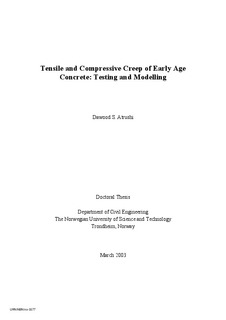| dc.description.abstract | The thesis deals with experimental and numerical modelling to characterize early age tensile and compressive creep and its associated stress relaxation - which are very important properties in stress simulation of early age concrete. For this purpose a comprehensive work was carried out involving construction of a new tensile creep test equipment and development of test procedures to generate basic experimental data.
The experimental program is subdivided into four series. Each of the series involves one varying parameter, which is relevant to the time-dependent behaviour of early age HPC. Most of the tests are repeated to check the reproducibility of the test results. The reproducibility of the test results for the BASE concretes confirmed that the experimental setup is reliable, and that it can be used to determine tensile creep of concrete at early ages.
An extensive test program has been performed on HPC, with w/b = 0.40. The primary parameters studied were concrete ages at loading (1, 2, 3, 4, 6 and 8 days), stress/strength levels (20-80%), and temperature levels (20, 34, 40, 57 and 60 oC) in addition to the effect of silica fume (0-15%) on tensile creep. The testing apparatus was new and significant efforts were devoted to develop reliable procedures in terms of accuracy and reproducibility. In parallel, compressive creep tests were conducted on a separate testing apparatus, and the results are compared to tensile creep behaviour.
It was found that the instantaneous deformation under tension is smaller than under compression, and that the corresponding creep curves also are different. Creep in tension is found to be lower initially, but an almost linear rate is soon established which is much higher than in compression. The consequence is greater creep magnitude and thus greater creep coefficient in tension than in compression. The tests on non-linearity showed that the proportionality limit between stress and sealed tensile creep strain is about 60% of the strength. Creep tests under isothermal temperatures showed that, as for compressive creep, the sealed tensile creep accelerates for temperatures higher than 20 oC. In addition, the maturity principle describes this effect reasonably well, for the tested loading ages of about 3 days.
The relatively large amount of experimental data, available in this study, has been used to investigate mathematical models. Comprehensive test results from the TSTM apparatus are analyzed with respect to creep and relaxation, where the effect of temperature on creep and relaxation is emphasized. Simulations of self-induced stresses are performed using the creep model denoted the Double Power Law (DPL). As solution method, the theory of linear viscoelasticity with aging is used. The model (M-DPL) is modified to take into account the effect of irrecoverable creep.
For increasing temperatures during the hardening phase, the transient creep, which takes place during heating is taken into account by an additional creep term. Its contribution to stress relaxation was found to be up to 10%. This transient creep term is considered to be irrecoverable during the subsequent temperature decrease. The modified model captures the various characteristics of sealed creep and describes the tensile behaviour at early ages more accurately than the original Double Power Law.
The effect of relaxation is found to be relatively large and significant in development of selfinduced stresses. Under isothermal temperature of 20 oC, the relaxation increases to about 40% of the fictive elastic stresses after 3 days and remains about constant after that. On the other hand, presentation of relaxation under realistic temperature histories is much more complicated, because the stresses change from compression to tension. This might also lead to increased tensile stresses because compressive creep reduces compressive stresses, but increases the subsequent tensile stresses. Underestimation of creep in this early period will lead to underestimation of the cracking risk.
Creep development at very early ages has an important effect in determination of the creep model parameters. After an evaluation of the test results using six loading ages (1, 2, 3, 4, 6 and 8 days) it was concluded that an optimal test program should include at least 3 loading ages, in which the loading ages 1 and 2 must be included.
Furthermore, the test results indicate that partial replacement of cement with silica fume (5-15%) increases the sealed tensile creep. However, the reference concrete without silica fume dose not fit to this systematic pattern. | nb_NO |
